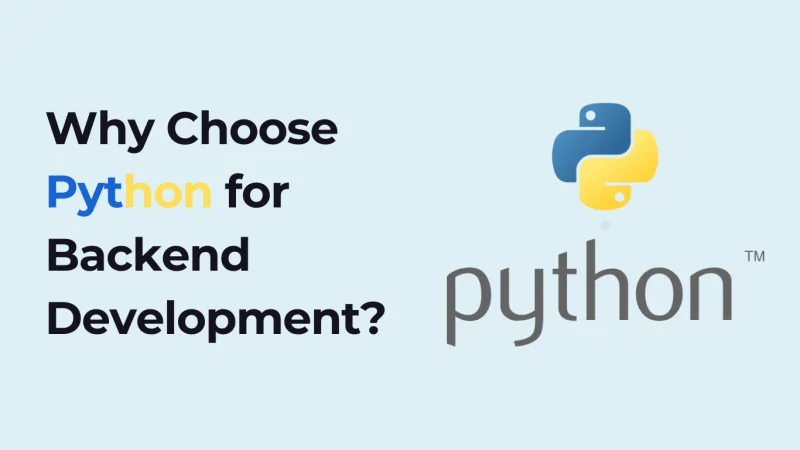Why choose Python for Backend Development?

Creating reliable and effective web applications is essential in today’s digital age. The backend manages the server setups, database interfaces, and logic that keep everything functioning properly. It is often referred to as the “brains” of a web application.
Python has emerged as the preferred language for backend development due to its ease of use and adaptability. In the artificial intelligence era, developers concentrate on making quicker and more automated apps.
Python speeds up development by enabling AI and machine learning tasks to be completed with fewer lines. Web developers also benefit greatly from Python for the backend since it makes jobs like database administration, front-end design, and website building simpler.
This tutorial will help you in knowing why you prefer Python & hire Python developers for backend development.
Top 6 Reasons to Choose Python for Backend Development
Python is the most popular programming language and is the first pick for various aspiring programmers. This language’s popularity can be attributed to many compelling factors. Check out a few of them.
#1 Usability
9 out of 10 programmers choose Python over other programming languages for this reason. Python’s clear syntax and ease of creating code make development simple and save time.
Codes are more organized and easier to understand when indentation is used in place of curly braces. Even for those who are new to programming, Python programs are simple because they lean more towards natural language. Python is utilized in web development, contributing to the efficiency and speed of website creation. It is used by many websites for front-end design, data management, user authentication, API development, and many other tasks. It provides a faster and more efficient way to create prototypes.
#2 Object Oriented Programming Language
One of Python’s most significant features that increases its effectiveness is its support for object-oriented programming. Failure rates are decreased by object-oriented programming since errors in one section of the code do not impact other sections. Python codes are modular, reusable, and well-structured thanks to OOPs. They are less complicated and have a clear framework. Python integrates effectively with OOPs’ encapsulation, abstraction, and polymorphism capabilities.
#3 Huge Libraries and Frameworks
Numerous libraries and frameworks with sophisticated capabilities and pre-made modules make up Python. With pre-defined modules and tools, the frameworks and libraries streamline and expedite the development of applications. Django, Numpy, Pandas, TensorFlow, PyTorch, Flask, and others are some of the well-known Python libraries.
#4 Extremely Active Community Support
There is a large online community for the Python language where a lot of software professionals interact and work on open projects. As Python gained popularity, their community increased and became stronger as well. The collaborative effort and contributions have produced a programming language that is rich in features and has a large number of library support and development frameworks. Developers may access a wealth of information and support anytime they need it. They have no trouble communicating with top developers worldwide. Stackoverflow, Github, Discord, and many more cross-platform communities also assist developers.
#5 Versatility and Speed
Python is a flexible language because it can be readily integrated with a wide range of fields. It includes computing, data science, machine learning, web development, and artificial intelligence development. This language is the first choice for all developers, regardless of experience level because of its huge versatility. Python facilitates rapid prototyping, speeding up development and deployment.
#6 Scalability and Performance
Python has good scalability to easily manage high application loads and can handle huge workloads with efficiency. It offers various management strategies that can control the massive volume of users and data. Additionally, it allows for multithreading, facilitating the execution of several tasks simultaneously. It has a large number of libraries for performance optimization. They can be used by developers to create applications with highly optimized code. Also, the code can be readily reused with the help of OOPs.
Python code can operate on various platforms and operating systems. For example, Windows, Mac, Linux, and others. Numerous well-known websites, including YouTube, Stack Overflow, Discord, and others, were created with Python. Python can handle HTTP requests and responses with ease with Django, Flask, Guvicorn, and other tools.
Conclusion
If you’re looking to hire backend developers, Python should be a top consideration.
Python is a great option for several reasons for backend development. Python is easy to learn and write code for. It boasts a sizable community that offers developers support and a wealth of resources, such as their in-depth documentation. Python can handle jobs like web scraping, web building, and machine learning since it is scalable and flexible. It fits in well with other libraries and other tool databases. Businesses can handle big datasets more effectively and derive insightful information with Python.
Many well-known businesses use and trust Python, a powerful back-end programming language. It guarantees scalability, efficiency, security, and many other qualitative factors relevant to contemporary apps.
Ti potrebbe interessare:
Segui guruhitech su:
- Google News: bit.ly/gurugooglenews
- Telegram: t.me/guruhitech
- X (Twitter): x.com/guruhitech1
- Bluesky: bsky.app/profile/guruhitech.bsky.social
- GETTR: gettr.com/user/guruhitech
- Rumble: rumble.com/user/guruhitech
- VKontakte: vk.com/guruhitech
- MeWe: mewe.com/i/guruhitech
- Skype: live:.cid.d4cf3836b772da8a
- WhatsApp: bit.ly/whatsappguruhitech
Esprimi il tuo parere!
Ti è stato utile questo articolo? Lascia un commento nell’apposita sezione che trovi più in basso e se ti va, iscriviti alla newsletter.
Per qualsiasi domanda, informazione o assistenza nel mondo della tecnologia, puoi inviare una email all’indirizzo [email protected].
Scopri di più da GuruHiTech
Abbonati per ricevere gli ultimi articoli inviati alla tua e-mail.
